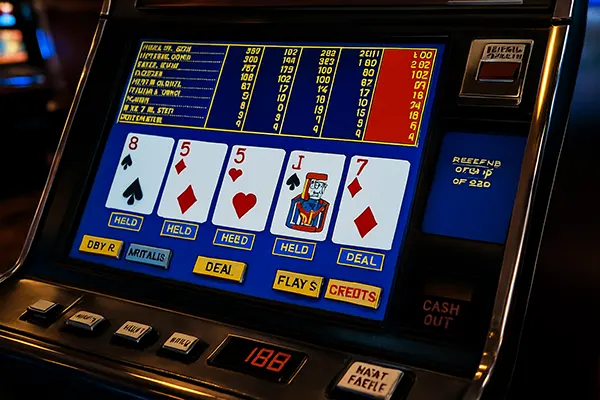Video Poker: Modern Variants, Strategies and Player Benefits

Video poker has remained one of the most recognisable gambling games since its introduction in the 1970s. Combining the appeal of slot machines with the strategic decision-making of poker, the game continues to evolve and attract new audiences. In 2025, players have access to a wide range of modern versions, digital enhancements, and tools that make gameplay both accessible and intellectually stimulating.
Modern Variants of Video Poker
The development of technology has expanded the number of video poker variants far beyond the classic Jacks or Better. Today’s libraries include options such as Deuces Wild, Bonus Poker, Double Double Bonus, and Joker Poker, each with unique rules and pay tables. These alternatives allow players to choose games that match their appetite for risk and their preference for payout structures.
Progressive video poker has also gained popularity. In these versions, part of each wager contributes to a growing jackpot, which can sometimes reach significant amounts. This element adds another dimension to the gameplay, blending the steady returns of standard pay tables with the excitement of chasing a large win.
Another innovation in recent years is multi-hand video poker. Instead of playing one hand per round, players can engage with ten, fifty or even one hundred hands at once. This format requires more attention but allows for faster accumulation of results, appealing to those who enjoy high-action sessions.
Technological Influence on Gameplay
The introduction of advanced random number generators has made video poker more reliable and transparent. Certified software ensures fair outcomes and increases player confidence. In addition, mobile compatibility means that video poker is now accessible across devices, whether on desktop, tablet, or smartphone.
Modern interfaces also feature customisable settings such as autoplay, adjustable speed, and detailed game statistics. These tools help players to track their progress and adapt their strategies in real time. Such developments create a more engaging and data-driven experience, particularly for those who enjoy analysing performance.
Live dealer versions of video poker, although less common than table games, are slowly entering the market. These add an interactive element, allowing players to communicate with hosts and observe card draws in real time, which enhances trust and social engagement.
Strategies for Successful Play
Unlike slots, video poker requires skill and decision-making. The basic principle is to choose which cards to hold and which to discard after the initial deal. Knowledge of optimal strategies for each variant can significantly reduce the house edge. For example, in Jacks or Better, keeping a low pair instead of breaking it for a potential straight is often mathematically superior.
Players often rely on strategy charts, which outline the best possible move for every situation. These charts are widely available and tailored to specific versions of the game. When followed consistently, they can transform video poker from a luck-based game into one where long-term skill plays a measurable role.
Bankroll management is another essential strategy. Given that video poker can be played at various stake levels, setting limits and sticking to them ensures sustainable play. Responsible management helps players to enjoy longer sessions and reduces the risk of chasing losses.
Mathematics and RTP Considerations
Each video poker variant has a defined return-to-player (RTP) percentage, which indicates the theoretical payout over time. Jacks or Better, when played with optimal strategy, often has an RTP above 99%, making it one of the most favourable options for skilled players.
Understanding variance is also important. High-volatility variants, such as Double Double Bonus, may deliver larger wins but with less frequency, while low-volatility versions provide steadier but smaller payouts. Players can select their preferred style depending on whether they value consistency or risk-taking.
Software providers often publish official RTP figures, and independent testing agencies verify these numbers. By choosing certified games, players gain additional confidence that results are accurate and fair.

Benefits of Playing Video Poker
One of the primary advantages of video poker compared to other games is its transparency. Since pay tables are visible and strategies are widely available, players have more control over their outcomes. This makes it attractive to individuals who value logic and informed decision-making.
Another benefit is the balance between entertainment and skill. While the game remains accessible to beginners, those who dedicate time to learning strategy can achieve results that approach mathematical perfection. This dual nature makes video poker appealing across a wide spectrum of players.
Finally, video poker is often considered a lower-risk option compared to many casino games. With the potential for high RTP and relatively stable payouts, it offers extended playtime without the extreme volatility associated with some modern slot titles.
Responsible Play and Accessibility
As with all gambling activities, responsible play is essential. Many providers include built-in tools such as session reminders, deposit limits, and self-exclusion options. These features support a safe gaming environment and help prevent problematic behaviour.
Accessibility has also improved, with inclusive design principles ensuring that interfaces are clear and user-friendly. This benefits not only seasoned players but also newcomers who may be less familiar with digital environments. Tutorials and demo versions further aid learning without financial risk.
In 2025, video poker continues to stand out as a blend of tradition and modernisation. By combining classic rules with contemporary technology, the game maintains its relevance while offering players a fair, strategic, and enjoyable experience.





